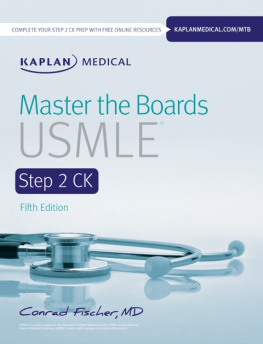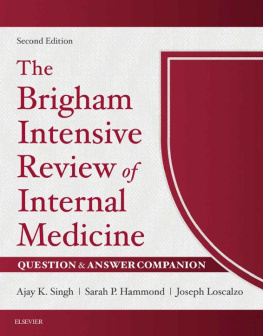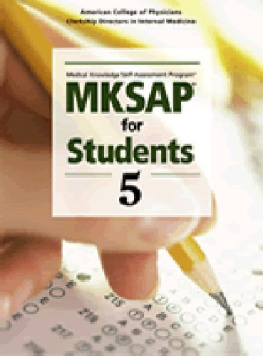A woman of extraordinary poise, wisdom, and grace. I see the world better because it is illuminated with a light you have helped me to grow in my own heart. I hope to teach others the beauty of making the slightest piece of ordinary employment an opportunity for devotion and reverence, as you have taught me.
Consider that all you are learning at this time is sacred material, and further, that the path of the physician is sacred.
Greetings on your journey of study. Although we have never met, I wish you well with all of my heart. This book brings you the best of the knowledge of our planet in the area of medicine. I hope these introductory words also bring a message of great hope and relaxation, because I know the process of Board-exam preparation at times will be very painful.
Allow me to suggest an experiment that may bring some relief to you: You may find it hard to believe that a mass of separate facts may be sacred. But to take the best of science and medicine and use it in the service of suffering humanity is indeed sacred. If something you learn in this book helps you save someones life, is that not sacred?
If you study with this in mind, preparation for Boards will no longer seem like an effort to smash into the mind a bunch of seemingly random facts that have no meaning. Let me go further and submit that in your study you are perfecting your art. The process can now be filled with a kind of aesthetic beauty. You will find new energy flowing into you, and you will be able to study longer and more keenly. You will become more knowledgeable than ever before.
Should a voice come up inside you asking, What am I doing todayjust cramming data to survive the Boards? you will answer, No, I am polishing the art of medicine in the service of humanity.
This has been my constant experienceas a practicing physician, a teacher, and a lifelong student. It has made all the difference.
Yours, Conrad Fischer
The essential feature of Dr. Fischers method of preparation for the boards is to put the student into the mind of the question writer.
As you study, think of the instructions given to the writers of Board questions. The writer analyzes each disease for the questions that can be extracted from that subject. The writer describes a case scenario with history, physical examination, and possibly some laboratory data. The writer will generate several basic questions for each data set:
What is the most likely diagnosis?
How can it be distinguished from similar diseases?
What are the few words in each question that will separate it from the other similar diseases?
Instead of memorizing an encyclopedia of raw data, learn this much smaller critical subset of medical decision points. While the world absurdly values the memorizer. Dr. Fischer salutes the intelligent lazy student who goes straight for the heart of medical decision making.
Learn the big four:
What is the best initial test?
What is the most accurate test?
What is the best initial therapy?
What is the best next step in management?
Dr. Fischers method is to extract the most likely answers to each of these four questions for each particular disease. Essentially, Dr. Fischer teaches you to pre-digest each disease for these four questions. You dont know which disease or question will be asked, so why not prepare for all of them? With this method you will have prepared for 80% of the questions, and of those questions that are left, 5 to 10% of the questions are experimental and you simply cannot predict the last 10%. With this method, you aim to efficiently get 80% of the answers correct so that you do more than just pass, you excel.
Theres more good news. With Dr. Fischers approach, studying now has practical limits. You have done enough by thinking like the question writer for each subject, and then by juicing out the answers to the big four questions. You will find that your reading is more efficient as you pull the essential material out of each disease. You can look forward to your studying, because the most essential feature of Dr. Fischers method is to make you your own teacher.
A 39-year-old Polish man comes to the clinic for painful calves after walking long distances and for discoloration of the fingers with changes in temperature. He says his symptoms started 2 months ago, and he gets no relief from the ibuprofen. He has previously been healthy. He currently smokes a pack a day and drinks socially. He has no history of drug abuse. On physical examination, his blood pressure is 140/90 mm Hg, heart rate is 68/min, and he is afebrile. Examination of the hands reveals distal digital ischemia and trophic changes in the nails of both hands. Radial pulses are absent bilaterally, but all other pulses are present. His right calf shows evidence of a superficial thrombophlebitis.
Laboratory studies show: white cell count 9,600/mm3, hematocrit 38.6%, MCV 89 m3, ESR 40 mm/h, and C-ANCA as negative. The rheumatoid factor and ANA are negative.
Which of the following should be done next for this patient?
A 65-year-old man presents to the emergency room with complaints of weakness, generalized swelling in his extremities, and right leg pain. At the time of presentation, he appears to be in moderate distress from the leg pain. The patient states that his symptoms started 2 days ago. The patient also has frequent urination and increased thirst. He states that he has felt weak for the past few months. Physical examination reveals a tender, erythematous, and swollen right calf. He also has 2+ pitting edema in all extremities. Blood pressure is 107/55 mm Hg, and temperature is 100.3 F. Venous ultrasound is positive for lower-extremity deep vein thrombosis.








